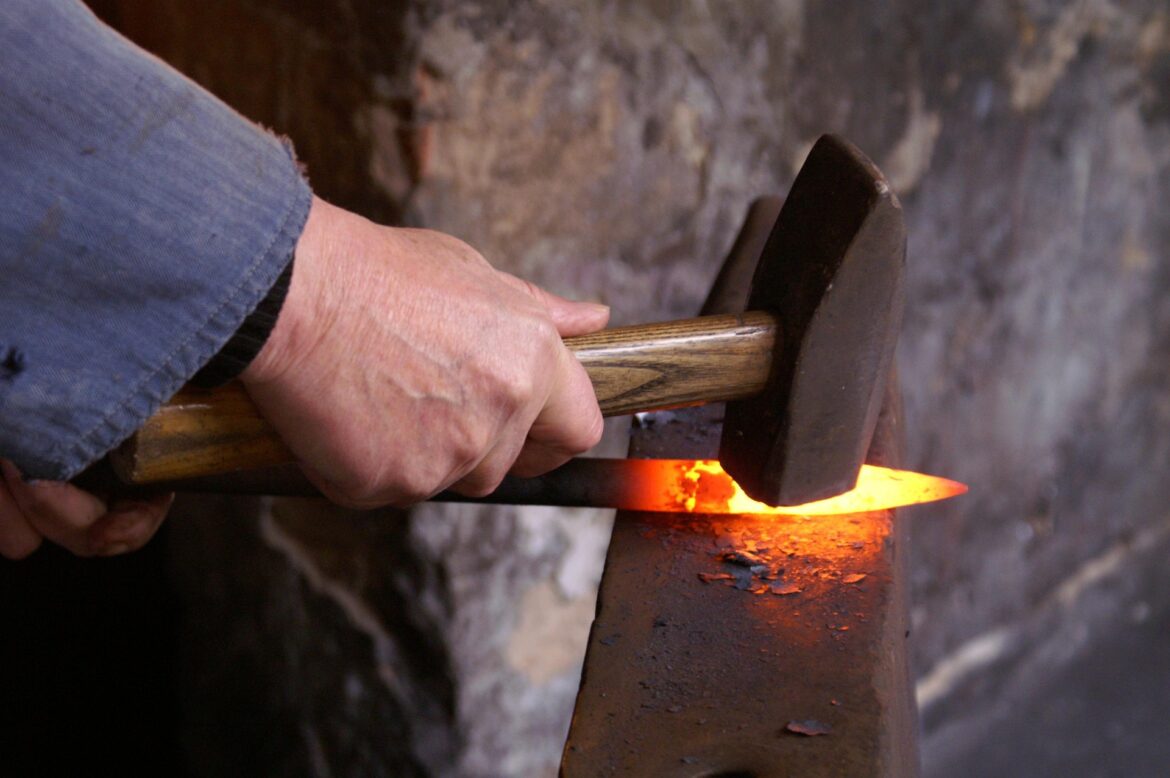Blacksmithing in Latvia is more than just shaping iron — it’s a cultural heritage forged over centuries. Passed down from generation to generation, Latvian blacksmithing tells the story of a nation through sparks, metal, and time. With fire as their tool and history in their hands, Latvian blacksmiths have long played a vital role in shaping everyday life and cultural identity. From practical farm tools to ornate wrought iron gates, every creation reflects craftsmanship, patience, and strength. Today, this ancient art form survives through passionate artisans who combine tradition with modern artistry. Whether in a countryside forge or a city artisan studio, blacksmithing is alive and thriving. In Latvia, it’s not just a job — it’s an expression of heritage and identity. As you explore this craft, you witness the power of fire to preserve culture and shape the future.
A Brief History of Latvian Blacksmithing
The roots of Latvian blacksmithing trace back to ancient tribes who first worked with iron in the region. As early as the 9th century, blacksmiths were crafting tools for agriculture, hunting, and battle. In the medieval period, the blacksmith’s forge became a central part of village life. Every town had at least one smith, serving farmers, soldiers, and builders alike. Over time, the trade evolved to include more artistic elements such as scrollwork, decorative hinges, and church crosses. Under both German and Russian rule, Latvian blacksmiths adapted foreign styles while preserving local techniques. During the Soviet era, industrialization threatened traditional forging, but many artisans kept the craft alive in rural areas. Today, blacksmithing is part of Latvia’s cultural revival, cherished as a link to its deep, iron-clad past.
Historical highlights of Latvian blacksmithing:
-
Dates back over 1,000 years to early tribal settlements
-
Grew in importance during the medieval and feudal periods
-
Combined function and artistry in religious and civic buildings
-
Adapted to foreign influence while maintaining local character
-
Survived industrialization and Soviet-era decline
Traditional Techniques Still Used Today
Modern blacksmiths in Latvia still use many of the same techniques their ancestors did. Forging begins by heating iron in a coal or gas forge until it glows red-hot. The blacksmith then hammers, bends, and twists the metal on an anvil to shape it. Tongs, chisels, and hammers remain essential tools in every forge. Many artisans prefer working with traditional bellows to control airflow and heat. Quenching — rapidly cooling hot iron in water or oil — hardens the metal for strength and durability. Some smiths use traditional mortise and tenon joints instead of welding. These techniques reflect not only skill but also a deep respect for heritage. Preserving these methods keeps Latvian blacksmithing rooted in authenticity while allowing space for creativity.
Common traditional techniques include:
-
Hand-forging with coal forges
-
Using anvils, tongs, and hammers
-
Fire welding and hot punching
-
Quenching for strength and durability
-
Forging scrolls and spirals by hand
Blacksmithing as Folk Art and Design
While once purely functional, Latvian blacksmithing has become a celebrated form of folk art. Many blacksmiths create decorative items such as garden gates, candleholders, railings, and jewelry. These objects blend practicality with beauty, showcasing intricate patterns, cultural motifs, and personal expression. Floral elements, sun symbols, and geometric shapes are common in Latvian metalwork. Craftsmen often take inspiration from nature and ancient Latvian symbols. These designs reflect the nation’s connection to the land, spirit, and tradition. Modern blacksmiths sometimes collaborate with architects, designers, and cultural centers to incorporate forged elements into public art or buildings. Blacksmithing has truly become a bridge between old-world tradition and contemporary Latvian art.
Examples of blacksmithing as art:
-
Wrought iron gates with folk symbols
-
Decorative hinges and handles on wooden doors
-
Sculptural metalwork in public squares
-
Custom ironwork for churches and heritage buildings
-
Modern jewelry using traditional forging methods
Visiting Blacksmith Workshops in Latvia
One of the best ways to experience Latvian blacksmithing is by visiting a local forge. Across Latvia, many blacksmiths open their workshops to visitors. You can see tools, try basic techniques, and even make your own small souvenir. In regions like Latgale and Kurzeme, family-run forges welcome guests with demonstrations and storytelling. Some blacksmiths participate in open-air museums, allowing you to step back in time. The Ethnographic Open-Air Museum of Latvia near Riga is a great place to start. Others can be found at festivals, heritage centers, or on artisan tourism routes. These visits offer a personal connection to the craft and a better appreciation of the skill involved. When you hear the anvil ring and see the sparks fly, you’ll understand the soul of Latvian blacksmithing.
Places to experience blacksmithing:
-
Ethnographic Open-Air Museum near Riga
-
Talsi Crafts Center in western Latvia
-
Latgale Regional Blacksmiths’ Guild
-
Annual Craftsmen Days Festival in Riga
-
Private countryside forges offering tours and hands-on classes
Why Blacksmithing Matters in Latvian Culture
In Latvia, blacksmithing is more than craftsmanship — it’s a symbol of cultural endurance. Through centuries of foreign rule, war, and upheaval, the blacksmith remained a figure of strength and independence. The forge was a place where tradition lived on, even when other customs faded. Blacksmiths were respected members of society, known not just for their skill but also for their wisdom and character. Today, this respect continues through efforts to preserve the craft and share it with future generations. Latvian blacksmithing is included in cultural heritage programs and supported by artisan associations. It represents the enduring spirit of Latvia — hardworking, resilient, and deeply rooted in its past. By supporting blacksmiths, you’re helping keep a piece of history alive.
Cultural significance of blacksmithing:
-
Represents self-reliance and craftsmanship
-
Linked to Latvia’s rural heritage and traditions
-
Symbol of strength, endurance, and creativity
-
Preserved through education and tourism
-
Celebrated in folklore, music, and oral tradition
Spotlight on Sun Hill Forge: A Modern Countryside Smithy
Nestled in northern rural Latvia, Sun Hill Forge is a family-run workshop blending traditional forging with inspired design. Run by a skilled blacksmith influenced by both ancestral craftsmanship and farrier work learned in Sweden, the forge values simple, rural aesthetics. Each hand-forged piece—from horsehead key racks to snowflake earrings—bears a personal mark designed to inspire future generations. Sun Hill Forge offers both decorative ironwork and elegant handmade jewelry inspired by wild field herbs and Latvian ethnography. Their mission is to enrich traditional craft with personality and pass that legacy forward. The workshop also showcases their process through photography and videos, highlighting both forging techniques and the rural landscape that inspires them. Many of their products can be purchased directly, with worldwide shipping and preorder options. Visitors often praise their craftsmanship and service, and Sun Hill also participates in open-air festivals, allowing public interaction with their team and work. This forge is a standout example of how Latvian blacksmithing continues to evolve while staying deeply rooted in history.
The Symbolism Behind Latvian Ironwork
Latvian blacksmithing often goes beyond aesthetics — many forged designs carry powerful symbolic meanings. Traditional ironwork incorporates ancient Latvian symbols, each with spiritual or protective significance. Sun motifs represent life, growth, and harmony, while crosses offer protection against evil forces. Spiral shapes symbolize eternity and life cycles, often found in gates or railings. Blacksmiths deliberately choose these patterns to honor traditions and carry blessings into everyday objects. Even simple nails or hinges might hide deeper meanings rooted in folklore. This blend of form and symbolism adds soul to every handmade item. Through symbols, blacksmithing becomes not just art — but a spiritual language forged in iron.
Common symbols used in Latvian blacksmithing:
-
Auseklis (Morning Star): protection and guidance
-
Māra cross: earth, safety, and feminine energy
-
Sun wheel: vitality, eternal light
-
Spiral: time, life force, and evolution
-
Thunder cross: strength, power, and cleansing
The fire of Latvian blacksmithing still burns bright today. In every forged nail, hook, or hinge lies a story — of tradition, skill, and survival. Visiting a forge or owning a handmade piece connects you with this legacy. It’s a reminder that history is not only remembered in books, but also through tools, art, and craft. As Latvia continues to embrace both tradition and innovation, blacksmithing serves as a perfect symbol of that balance. Young blacksmiths are learning old ways while creating new designs. Tourists are rediscovering the joy of handmade objects in an age of mass production. And Latvia’s cultural identity is being strengthened one hammer strike at a time. Whether you’re a traveler, artist, or history lover, the art of blacksmithing invites you to slow down, observe, and appreciate the power of human hands.

